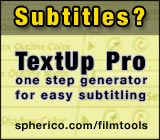|
|
Forum List
>
Café LA
>
Topic
Editing Newbie
Posted by joebreaux
|
Editing Newbie May 10, 2008 05:19AM |
Registered: 16 years ago Posts: 2 |
|
Re: Editing Newbie May 10, 2008 05:21AM |
Moderator Registered: 17 years ago Posts: 8,836 |
|
Re: Editing Newbie May 10, 2008 06:34AM |
Registered: 18 years ago Posts: 226 |
|
Re: Editing Newbie May 10, 2008 07:53AM |
Moderator Registered: 18 years ago Posts: 7,458 |
|
Re: Editing Newbie...More Info... May 10, 2008 11:53AM |
Registered: 16 years ago Posts: 2 |
Hey Guys,
Thanks for the info and sorry for not enough information...
The difference between the 2 shots is that the actor is not exactly doing the same thing...
For example Clip A he's closing his phone to fast and Clip B he takes a little longer to close his phone... He is not in the exact same position in the shot... but I like to combine the 2 clips seamlessly...
I think I am trying to match frame and there is no sound involved...
I hope this is enough information...if not let me know...
Thanks for your help
Joe
Thanks for the info and sorry for not enough information...
The difference between the 2 shots is that the actor is not exactly doing the same thing...
For example Clip A he's closing his phone to fast and Clip B he takes a little longer to close his phone... He is not in the exact same position in the shot... but I like to combine the 2 clips seamlessly...
I think I am trying to match frame and there is no sound involved...
I hope this is enough information...if not let me know...
Thanks for your help
Joe
|
Re: Editing Newbie...More Info... May 10, 2008 12:00PM |
Moderator Registered: 17 years ago Posts: 8,836 |
>Right now it seems like the answer to your question is 'editing'.
Sounds like it, Jude.
Joe, on your question... The position of where he's standing generally doesn't matter, as long as the shot sizes/ angles are different enough, and the cut is made to an action and the point seems natural enough. But if you're trying to pick up editing, it's going to be kinda hard to teach over a forum. For starters, you could go try wikipedia, study lots of films, maybe enroll in a film school near you.
[en.wikipedia.org]

www.strypesinpost.com
Sounds like it, Jude.
Joe, on your question... The position of where he's standing generally doesn't matter, as long as the shot sizes/ angles are different enough, and the cut is made to an action and the point seems natural enough. But if you're trying to pick up editing, it's going to be kinda hard to teach over a forum. For starters, you could go try wikipedia, study lots of films, maybe enroll in a film school near you.
[en.wikipedia.org]

www.strypesinpost.com
|
Re: Editing Newbie...More Info... May 10, 2008 12:18PM |
Moderator Registered: 18 years ago Posts: 10,771 |
> The difference between the 2 shots is that the actor is not exactly doing the same thing...
> For example Clip A he's closing his phone to fast and Clip B he takes a little longer to close his
> phone... He is not in the exact same position in the shot... but I like to combine the 2 clips
> seamlessly...
> I think I am trying to match frame and there is no sound involved...
You're kind of asking us to help you make a very specific editing decision on two shots without having seen the shots themselves! Pretty hard to do.
But here's something they don't teach enough at film schools...
Cutting on action is tremendously overrated. What's more important is the motivation for the cut. For example, I'm guessing you're trying to let him start closing the phone in the outgoing shot, and picking up the action on the incoming shot, and the actions aren't matching. Well, then, don't cut on the action! Cut right before he starts closing his phone. The motivation for the cut, then, is to show his action of closing his phone. Or, cut right after he closes the phone and pick up the shot right after the action. The motivation, then, is to show what he does after he wraps his shot. Here's a third option: Don't cut at all. Do you have to go to the second shot? If so, what's its purpose? What was the purpose of the outgoing shot? Can it stay alive through the closing-phone beat? Your decision will also be dictated by whether the fast action or the slower action works better. What makes more sense for his character? Is he frantic or relaxed? Jittery or confident? And what's more fitting for your scene?
One of the most common student-film mistakes is to obsessively cut on actions. Every time a character does something, student filmmakers usually feel compelled to cut to another shot because cutting on action "makes it look smooth". Well, no audience member gives a horse's patootie whether a cut is smooth if the scene is engaging. Cut for meaning, cut for necessity; don't let movements dominate your editing decisions. If you cut at the right spot for showing what you need to, rather than obsessively making the match-action look "smooth", you'll be surprised how smooth things can look. Because logic trumps visuals. Try cutting more with your head (logic of the scene, meaning, rhythm, emotion, narrative flow), and a little less with your eyes (matching action, 2D and 3D continuity, visual flow, pretty lighting).
In the last short film I edited, the director and I made a painful decision to kill one shot where the main character turns her head to camera. It was originally intended to be her character reveal, the first time we see her entire face. She looked just great in the shot, her eyes were engaging, the action was dramatic, with her head-turn almost symbolizing her entire struggle throughout the film, and I actually used it for her ending shot when I cut the trailer for the film. But within the context of the film (first scene of the film), it was just too huge. The scene was naturalistic, and her entrance became almost melodramatic with that shot in; it didn't fit with the actual moment in the film. So out it went, even though I'd say it ranked among my three favourite shots among the raw footage. Yes, we lost a great shot, but we gained a better film.

www.derekmok.com
> For example Clip A he's closing his phone to fast and Clip B he takes a little longer to close his
> phone... He is not in the exact same position in the shot... but I like to combine the 2 clips
> seamlessly...
> I think I am trying to match frame and there is no sound involved...
You're kind of asking us to help you make a very specific editing decision on two shots without having seen the shots themselves! Pretty hard to do.
But here's something they don't teach enough at film schools...
Cutting on action is tremendously overrated. What's more important is the motivation for the cut. For example, I'm guessing you're trying to let him start closing the phone in the outgoing shot, and picking up the action on the incoming shot, and the actions aren't matching. Well, then, don't cut on the action! Cut right before he starts closing his phone. The motivation for the cut, then, is to show his action of closing his phone. Or, cut right after he closes the phone and pick up the shot right after the action. The motivation, then, is to show what he does after he wraps his shot. Here's a third option: Don't cut at all. Do you have to go to the second shot? If so, what's its purpose? What was the purpose of the outgoing shot? Can it stay alive through the closing-phone beat? Your decision will also be dictated by whether the fast action or the slower action works better. What makes more sense for his character? Is he frantic or relaxed? Jittery or confident? And what's more fitting for your scene?
One of the most common student-film mistakes is to obsessively cut on actions. Every time a character does something, student filmmakers usually feel compelled to cut to another shot because cutting on action "makes it look smooth". Well, no audience member gives a horse's patootie whether a cut is smooth if the scene is engaging. Cut for meaning, cut for necessity; don't let movements dominate your editing decisions. If you cut at the right spot for showing what you need to, rather than obsessively making the match-action look "smooth", you'll be surprised how smooth things can look. Because logic trumps visuals. Try cutting more with your head (logic of the scene, meaning, rhythm, emotion, narrative flow), and a little less with your eyes (matching action, 2D and 3D continuity, visual flow, pretty lighting).
In the last short film I edited, the director and I made a painful decision to kill one shot where the main character turns her head to camera. It was originally intended to be her character reveal, the first time we see her entire face. She looked just great in the shot, her eyes were engaging, the action was dramatic, with her head-turn almost symbolizing her entire struggle throughout the film, and I actually used it for her ending shot when I cut the trailer for the film. But within the context of the film (first scene of the film), it was just too huge. The scene was naturalistic, and her entrance became almost melodramatic with that shot in; it didn't fit with the actual moment in the film. So out it went, even though I'd say it ranked among my three favourite shots among the raw footage. Yes, we lost a great shot, but we gained a better film.

www.derekmok.com
|
Re: Editing Newbie May 10, 2008 12:25PM |
Moderator Registered: 18 years ago Posts: 6,730 |
|
Re: Editing Newbie...More Info... May 10, 2008 12:45PM |
Registered: 18 years ago Posts: 1,217 |
Thoughtful post Derek. We need more of these kinds of suggestions. I have a strong tendency to go for the visual rather than the cerebral. Fortunately, I catch myself most of the time.
And welcome Joe. We were all newbs once.
Kevin Monahan
Social Support Lead, DV Products
Adobe
Adobe After Effects
Adobe Premiere Pro
Adobe After Effects and Premiere Pro Community Blog
Follow Me on Twitter!
And welcome Joe. We were all newbs once.
Kevin Monahan
Social Support Lead, DV Products
Adobe
Adobe After Effects
Adobe Premiere Pro
Adobe After Effects and Premiere Pro Community Blog
Follow Me on Twitter!
|
Re: Editing Newbie May 10, 2008 01:01PM |
Registered: 18 years ago Posts: 177 |
|
Re: Editing Newbie...More Info... May 10, 2008 01:30PM |
Moderator Registered: 17 years ago Posts: 8,836 |
>Yes, we lost a great shot, but we gained a better film.
None better said than in these words. Sometimes i work on storyboards with lots of nice scenic shots, but always, the question is- are they necessary? Pretty shots always look good on storyboards, especially in color. But which ones tell the story?

www.strypesinpost.com
None better said than in these words. Sometimes i work on storyboards with lots of nice scenic shots, but always, the question is- are they necessary? Pretty shots always look good on storyboards, especially in color. But which ones tell the story?

www.strypesinpost.com
|
Re: Editing Newbie May 10, 2008 02:49PM |
Registered: 18 years ago Posts: 226 |
Excellent post Derek. And i second Kevin: We could do with more of this kind of discussion.
I'm reading "The Eye Is Quicker" by Richard Pepperman which explicitly deals with the kind of decisions you're making Joe.
Well worth a look, though it would make a lot more sense if you had the actual sequences he writes about in front of you. Which i don't unfortunately.
I'm reading "The Eye Is Quicker" by Richard Pepperman which explicitly deals with the kind of decisions you're making Joe.
Well worth a look, though it would make a lot more sense if you had the actual sequences he writes about in front of you. Which i don't unfortunately.
|
Re: Editing Newbie May 10, 2008 02:57PM |
Registered: 16 years ago Posts: 128 |
Derek,
May I have permission to quote you on my editing wiki?
Nice post.
--
Eric Harnden
Quintessential Studios
---------------------------------
[wordpress.quintessentialstudios.net]
[twitter.com]
May I have permission to quote you on my editing wiki?
Nice post.
--
Eric Harnden
Quintessential Studios
---------------------------------
[wordpress.quintessentialstudios.net]
[twitter.com]
|
Re: Editing Newbie...More Info... May 10, 2008 03:03PM |
Admin Registered: 18 years ago Posts: 6,740 |
|
Re: Editing Newbie May 10, 2008 05:40PM |
Moderator Registered: 18 years ago Posts: 6,730 |
|
Re: Editing Newbie...More Info... May 10, 2008 05:42PM |
Moderator Registered: 18 years ago Posts: 10,771 |
> Which brings us to another "rule"
> Never fall in love with your material.
Here's a corollary to Michael's rule:
"Never hate your own material."
When I was in film school I got the chance to recut some films that the director couldn't finish. And while lots of directors fell in love with certain shots ("babies" and stubbornly refuse to lose them to make the film better, just as often, I saw directors who tried to cut their own films, didn't succeed, and then started hating everything...even the scenes, shots, story beats and performances that worked.
and stubbornly refuse to lose them to make the film better, just as often, I saw directors who tried to cut their own films, didn't succeed, and then started hating everything...even the scenes, shots, story beats and performances that worked.
Gotta be able to see not just what's bad, but what's good. Scene B often fails not because there's something wrong with Scene B, but because Scene A didn't set it up properly. This is what Walter Murch astutely calls "referred pain".
I was proud of that example above, and equal credit has to go to the director, Randy. He allows me to make brutal, brutal cuts and sometimes suggests some that even I hadn't thought of. Boom, two minutes of fat trimmed from the film! That's real discipline. And he's also told me (which I agree) that he wouldn't be putting the cutting-room floor material back in, even if he could do a "director's cut". Because we cut that stuff out for a reason. DVD bonuses, maybe, but not back into the film. In fact, just two weeks ago I gave him the first cut of his film-school thesis (2002) and the first assembly of our last film (2006). The former film's first cut was 33 minutes (final product: 24 minutes) and the latter film's first cut was 37 minutes (final product: 29 minutes). We both had a great laugh at the shots and scenes that we amputated from the film.
> May I have permission to quote you on my editing wiki?
Sure, Eric, go ahead.

www.derekmok.com
> Never fall in love with your material.
Here's a corollary to Michael's rule:
"Never hate your own material."
When I was in film school I got the chance to recut some films that the director couldn't finish. And while lots of directors fell in love with certain shots ("babies"
 and stubbornly refuse to lose them to make the film better, just as often, I saw directors who tried to cut their own films, didn't succeed, and then started hating everything...even the scenes, shots, story beats and performances that worked.
and stubbornly refuse to lose them to make the film better, just as often, I saw directors who tried to cut their own films, didn't succeed, and then started hating everything...even the scenes, shots, story beats and performances that worked.
Gotta be able to see not just what's bad, but what's good. Scene B often fails not because there's something wrong with Scene B, but because Scene A didn't set it up properly. This is what Walter Murch astutely calls "referred pain".
I was proud of that example above, and equal credit has to go to the director, Randy. He allows me to make brutal, brutal cuts and sometimes suggests some that even I hadn't thought of. Boom, two minutes of fat trimmed from the film! That's real discipline. And he's also told me (which I agree) that he wouldn't be putting the cutting-room floor material back in, even if he could do a "director's cut". Because we cut that stuff out for a reason. DVD bonuses, maybe, but not back into the film. In fact, just two weeks ago I gave him the first cut of his film-school thesis (2002) and the first assembly of our last film (2006). The former film's first cut was 33 minutes (final product: 24 minutes) and the latter film's first cut was 37 minutes (final product: 29 minutes). We both had a great laugh at the shots and scenes that we amputated from the film.
> May I have permission to quote you on my editing wiki?
Sure, Eric, go ahead.

www.derekmok.com
|
Re: Editing Newbie May 11, 2008 03:49PM |
Registered: 18 years ago Posts: 89 |
Is it possible that there's a misunderstanding going on? he says:
"several clips with multiple takes"
is he's asking if he combine 2 different TAKES of the same shot? 2 diff takes of say the master shot?
if that is, in fact the case, and you're not looking for a jump cut in terms of aesthetic, the short answer is no.
"several clips with multiple takes"
is he's asking if he combine 2 different TAKES of the same shot? 2 diff takes of say the master shot?
if that is, in fact the case, and you're not looking for a jump cut in terms of aesthetic, the short answer is no.
|
Re: Editing Newbie May 11, 2008 08:53PM |
Registered: 18 years ago Posts: 981 |
Sorry, only registered users may post in this forum.



 All the news now and in your digital future
All the news now and in your digital future


